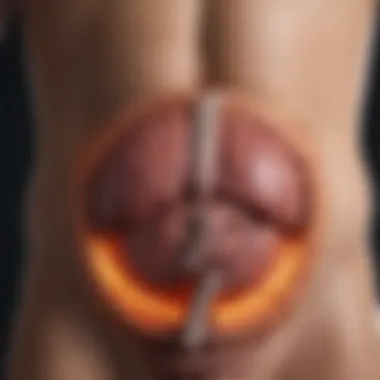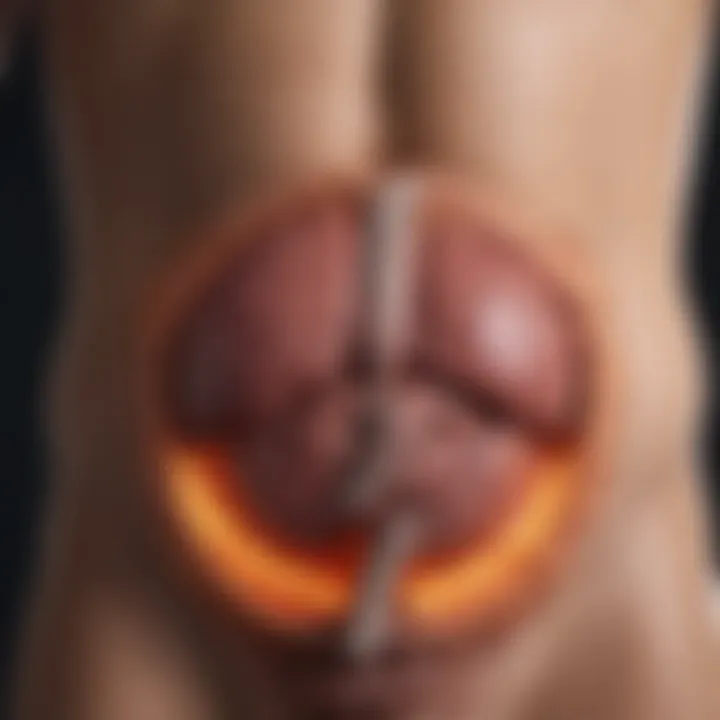Understanding Upper Stomach Pain and Nausea


Intro
Upper stomach pain and nausea are common symptoms that can be indicative of various underlying health issues. An intricate understanding of these symptoms is essential for accurate diagnosis and treatment. Recognizing the connection between these two phenomena can lead to better healthcare decisions, making it crucial to explore their relationship comprehensively. This guide will delve into various causes, diagnostic methods, and treatment options related to upper abdominal discomfort and nausea.
Research Overview
Methodological Approaches
To grasp the complexities behind upper stomach pain and nausea, various methodological approaches are employed. Clinical studies, observational research, and case studies offer valuable insights into the potential causes. Gathering data through patient interviews, surveys, and medical histories allows professionals to identify patterns and risk factors related to these symptoms.
Significance and Implications
Understanding the connection between upper stomach pain and nausea is of great significance. These symptoms can arise from simple conditions, such as indigestion or gastritis, but they can also signal more severe issues like pancreatitis or peptic ulcers. Timely recognition and intervention are paramount for managing these health concerns effectively.
"Symptoms, while appearing straightforward, can often mask complex underlying conditions that require careful evaluation."
Causes of Upper Stomach Pain and Nausea
Multiple factors can cause upper stomach pain and nausea. Below are some common and notable causes:
- Gastritis: Inflammation of the stomach lining can cause discomfort and nausea.
- Peptic Ulcers: Open sores in the stomach or duodenum can lead to significant pain.
- Pancreatitis: Inflammation of the pancreas produces severe pain, often accompanied by nausea.
- Gallstones: Hard deposits can obstruct the bile ducts, leading to digestive discomfort.
Other less common causes may include infections, food intolerances, or gastrointestinal disorders.
Current Trends in Science
Innovative Techniques and Tools
Advancements in diagnostic tools have improved the understanding of upper stomach pain and nausea. Endoscopy, ultrasound imaging, and various laboratory tests help refine the diagnostic process. With technology, it's now easier to visualize potential issues within the gastrointestinal tract.
Interdisciplinary Connections
Research into upper stomach pain and nausea shows strong interdisciplinary connections between gastroenterology, nutrition, and psychology. The interplay of physical health, diet, and mental well-being can influence these symptoms. Understanding this relationship is vital for comprehensive treatment.
The End
Preface to Upper Stomach Pain and Nausea
Upper stomach pain and nausea are complex symptoms that can indicate a range of underlying health issues. This introduction explains the significance of understanding these symptoms for both patients and healthcare providers. Grasping the nuances of upper stomach pain, alongside experiencing nausea, can assist in forming more accurate diagnoses and more effective treatment plans. In many instances, these symptoms are not standalone but are part of a broader clinical picture that may require extensive evaluation. It is, therefore, vital for individuals experiencing these symptoms to engage thoughtfully with their healthcare providers.
A clear definition of upper stomach pain can help establish a baseline for understanding medical consultations. Similarly, an examination of nausea clarifies its role as a symptom often accompanying discomfort. Recognizing these elements improves patient awareness and prepares them to discuss their symptoms effectively with medical professionals.
In summary, this section not only highlights crucial aspects regarding upper stomach pain and nausea but also sets the stage for delving into specific causes and implications throughout the subsequent sections of the article. It encourages an informed perspective that is critical when navigating potential healthcare pathways.
Anatomy of the Upper Abdomen
Understanding the anatomy of the upper abdomen is crucial in exploring the causes and implications of upper stomach pain and nausea. This section illuminates the key organs and structures within this region, as well as the nerve pathways involved in transmitting pain signals. Such knowledge not only enriches comprehension but also forms a foundation for recognizing potential health issues.
Key Organs and Structures
The upper abdomen houses several vital organs that play significant roles in digestion and metabolic processes. The primary organs include:
- Stomach: Responsible for breaking down food and beginning the digestion process through mechanical and chemical means.
- Liver: Vital for detoxification, protein synthesis, and production of biochemicals necessary for digestion. The liver also stores glycogen.
- Pancreas: Functions both as an endocrine gland and a digestive organ, producing enzymes necessary for digesting fats, carbohydrates, and proteins.
- Gallbladder: Stores and concentrates bile from the liver, releasing it into the small intestine to aid in fat digestion.
- Spleen: Involved in filtering blood and supporting the immune system, though its primary function is not digestion.
Problems in any of these organs can result in upper stomach pain and nausea. Conditions such as gastritis or pancreatitis often manifest in this area, emphasizing the need for an understanding of their locations and functions.
Nerve Pathways Involved
The body communicates sensations of pain through complex nerve pathways. The upper abdomen is innervated by various nerve fibers, including:
- Vagus Nerve: This cranial nerve influences the stomach's functions and can transmit feelings of fullness and discomfort.
- Thoracic Splanchnic Nerves: These nerves play a role in relaying pain signals from the abdominal organs to the spinal cord and then to the brain.
- Sympathetic Nervous System: Involved in the fight or flight response, it can amplify pain sensations in response to stress.
- Parasympathetic Nervous System: Works to calm the body and can help mitigate pain signals.
Understanding these pathways is essential. Disruptions may indicate serious health issues, suggesting the need for careful evaluation and possible intervention.
Recognizing how these components interact will aid in the understanding of upper stomach pain and nausea. It equips readers with the necessary insights to make informed decisions regarding their health.
Common Causes of Upper Stomach Pain
Understanding the common causes of upper stomach pain is crucial, as it enables better identification and management of the underlying issues. Recognizing these causes can help inform necessary lifestyle adjustments or medical interventions. Additionally, knowing the specific reasons behind upper stomach pain can provide clarity on when to seek expert advice. With this knowledge, individuals can take a proactive approach to their health, making more informed choices related to treatment and prevention.
Gastrointestinal Disorders
Peptic Ulcers
Peptic ulcers represent a significant source of upper stomach pain. These sores develop on the lining of the stomach or the first part of the small intestine. A key characteristic of peptic ulcers is their association with Helicobacter pylori infection or the prolonged use of nonsteroidal anti-inflammatory drugs (NSAIDs). In this article, discussing peptic ulcers helps elucidate their abdominal discomfort and potential complications, which can include bleeding or perforation. Understanding the nature of these ulcers can frame a comprehensive view of how upper stomach pain manifests and its treatment options.
Gastroesophageal Reflux Disease
Gastroesophageal Reflux Disease (GERD) is another prevalent condition that leads to upper stomach pain. It arises when stomach acid frequently flows back into the esophagus, causing irritation. One notable aspect of GERD is its chronic nature, which can significantly impact quality of life. Highlighting GERD in this article provides insights into how esophageal discomfort is frequently perceived as stomach pain. This connection emphasizes the importance of understanding the digestive pathway and its impact on health.
Gastritis


Gastritis refers to the inflammation of the stomach lining, which can trigger pain and discomfort in the upper abdomen. It can be acute or chronic, and its causes range from infections to excessive alcohol consumption. A unique feature of gastritis is its tendency to fluctuate, with symptoms varying in intensity. Discussing gastritis in this context offers readers a broad understanding of another source of pain, allowing for better management strategies and awareness of dietary influences on gastrointestinal health.
Pancreatic Conditions
Pancreatitis
Pancreatitis, or inflammation of the pancreas, leads to significant and often severe upper stomach pain. It is essential to highlight the acute and chronic forms of this condition, as each presents differently and requires different management strategies. Acute pancreatitis can develop suddenly, often due to gallstones or excessive alcohol intake, while chronic pancreatitis results from long-term inflammation. The understanding of pancreatitis brings crucial context to upper stomach pain, as this condition often necessitates immediate medical attention due to its potential complications.
Pancreatic Cancer
Pancreatic cancer, though less common, is an important consideration in the context of upper stomach pain. This type of cancer tends to present late with vague symptoms, making its earlier diagnosis challenging. The unique feature of pancreatic cancer is that pain is often a late symptom in its progression. Including it in this article highlights the significance of awareness regarding unusual or persistent pain, stressing the need for thorough evaluation, especially when accompanied by related symptoms.
Gallbladder Issues
Cholecystitis
Cholecystitis is the inflammation of the gallbladder, usually due to the presence of gallstones. One significant aspect is that the pain is often acute and sharp, particularly following a fatty meal. This condition emphasizes the role of dietary choices in the management of upper stomach pain. Recognizing cholecystitis in this article aids in understanding how dietary modification and medical intervention can effectively relieve symptoms.
Gallstones
Gallstones are hardened deposits that can form in the gallbladder and cause intense pain in the upper abdomen, often described as biliary colic. A key characteristic is the occasional silent nature of these stones, which can be asymptomatic until they obstruct the bile duct. Discussing gallstones deepens the understanding of upper stomach pain, as it provides insight into prevention through diet and lifestyle, potentially averting more severe complications.
Psychosomatic Factors
Psychosomatic factors play a critical role in understanding the intricate relationship between upper stomach pain and nausea. These factors focus on how psychological conditions can influence physiological symptoms. Stress, anxiety, and psychological disorders can all manifest physically, causing or exacerbating abdominal discomfort and nausea. This connection underscores the need to explore mental health aspects when assessing gastrointestinal symptoms.
Stress and Anxiety
Stress and anxiety are significant contributors to upper stomach pain and nausea. When an individual experiences stress, the body activates its fight-or-flight response. This response releases hormones such as adrenaline and cortisol, leading to various reactions, including increased heart rate and heightened sensitivity of the gastrointestinal (GI) tract.
Chronic stress can result in hyperactivity of the gut, which may lead to conditions such as gastrointestinal reflux disease and functional dyspepsia. Symptoms may include:
- Persistent upper abdominal pain
- Nausea and vomiting
- Changes in appetite
In addition to physical symptoms, anxiety can worsen pain perception. Individuals with anxiety disorders often report increased sensitivity to pain sensations. Therefore, managing stress through relaxation techniques or counseling can be beneficial for those experiencing upper stomach discomfort.
Psychological Disorders
Psychological disorders such as depression and anxiety disorders can significantly affect physical health. Individuals suffering from these conditions often experience various physical symptoms, including upper stomach pain and nausea. This manifests as psychosomatic symptoms, where the individual’s psychological state directly impacts their physical health.
Research suggests that there is a bidirectional relationship between psychological disorders and gastrointestinal symptoms. For instance, a person with chronic anxiety may experience ongoing nausea due to increased stomach acid production or stress-induced muscle tension in the abdomen.
Several approaches can help in addressing these issues:
- Cognitive Behavioral Therapy (CBT): This form of therapy can help individuals manage stress, leading to reduced physical symptoms.
- Mindfulness Techniques: Practices like meditation or yoga can mitigate the effects of stress on the gut.
- Medication: In some instances, antidepressants can also assist in alleviating gastrointestinal symptoms connected to psychological issues.
Understanding these psychosomatic factors is crucial in providing comprehensive care, ensuring that treatment plans encompass both psychological and physical health aspects.
Less Common Causes of Upper Stomach Pain and Nausea
Understanding less common causes of upper stomach pain and nausea is critical. While gastrointestinal issues are often the main focus, cardiac conditions and infections can also present these symptoms. Recognizing these factors can lead to more accurate diagnoses and treatment. It is essential to consider the rarer origins of discomfort, as they can often be serious and require immediate attention. Awareness of these causes can aid individuals in making informed health choices.
Heart Conditions
Myocardial Infarction
Myocardial infarction, commonly known as a heart attack, can manifest with upper stomach pain and nausea. It is important to understand that heart-related symptoms often extend beyond the typical chest pain. Many individuals may overlook the pain felt in the upper stomach, attributing it to digestive issues instead. The key characteristic of myocardial infarction is pain that may radiate, sometimes confusing symptoms with gastrointestinal disorders.
This is a significant aspect to address in this article. Recognizing that upper stomach pain can be a sign of cardiac distress is beneficial. It encourages readers to consider the broader implications of their symptoms. One unique feature is the occurrence of nausea, which can accompany other frustrating symptoms like sweating and lightheadedness. This can mislead individuals into underestimating the urgency of their situation. Immediate medical attention is paramount in cases of suspected heart attack.
Angina Pectoris
Angina pectoris refers to chest pain due to reduced blood flow to the heart, but it can also present as discomfort in the upper abdomen. This highlights the importance of understanding angina in conjunction with gastrointestinal symptoms. The primary characteristics of angina pectoris are short, recurring episodes of chest or related pain, typically triggered by physical exertion or stress.
Incorporating this into our discussion helps to illustrate the multifaceted nature of upper stomach pain. Angina pectoris serves as a critical reminder of the heart's role in abdominal sensations. Unlike myocardial infarction, angina may go away with rest, which adds complexity to its recognition. It is crucial for individuals to know that if they experience recurrent pain in the upper stomach, it might be linked to their heart health, thus warranting further investigation.
Infections
Helicobacter Pylori
Helicobacter pylori is a type of bacteria notorious for causing stomach ulcers and chronic gastritis. Its role in upper stomach pain and nausea cannot be overstated. One significant aspect of H. pylori is its persistent infection without immediate symptoms for many. This characteristic makes it particularly insidious, as it can lead to serious complications if left untreated. Recognizing this bacteria’s presence can be pivotal, especially in understanding the long-term impacts on gastric health.
Highlighting this pathogen in the article is key. It allows readers to comprehend how these hidden infections could lead to discomfort. Testing for H. pylori is straightforward and involves breath, stool, or biopsy tests. Treatment typically includes a course of antibiotics and proton pump inhibitors. This approach offers numerous advantages, including a high success rate in eradication, which can ultimately enhance stomach health significantly.
Viral Gastroenteritis
Viral gastroenteritis, often referred to as the stomach flu, can lead to upper abdominal pain accompanied by nausea and vomiting. This infection is characterized by inflammation of the stomach and intestines, usually caused by a virus. Symptoms can appear suddenly, which contributes to a sudden impact on daily activities. Recognizing this infection is vital since it has distinct treatment pathways compared to other causes.
The unique feature of viral gastroenteritis is its highly contagious nature. Understanding how it spreads can aid individuals in taking preventative measures, such as practicing good hygiene. While most people recover within a few days, dehydration becomes a concern, especially in more severe cases, making monitoring symptoms essential. Knowing when to seek medical evaluation is crucial, particularly when symptoms persist or worsen.
Medications and Toxins


Certain medications and toxins can also lead to upper stomach pain and nausea. Various pain relievers, such as non-steroidal anti-inflammatory drugs (NSAIDs) like ibuprofen or aspirin, can irritate the stomach lining. This irritation can produce discomfort similar to gastrointestinal disorders. Moreover, some prescription medications may carry gastrointestinal side effects, making a thorough review of current medications essential when diagnosing upper stomach issues.
Toxins, whether from food or environmental exposure, can contribute to gastrointestinal distress. Understanding this wide array of potential causes is important to address during diagnostic discussions. While less common, these factors should not be dismissed. A holistic approach that includes medication history and exposure to toxins can lead to more accurate diagnoses and appropriate management strategies.
Physiological Mechanisms
Understanding the physiological mechanisms behind upper stomach pain and nausea is crucial in navigating the broad spectrum of causes and implications these symptoms entail. The processes involved in both sensations reveal much about underlying health issues and guide health interventions. Knowing how pain and nausea manifest not only aids in diagnosis but also shapes treatment decisions.
How Pain Signals are Generated
Pain signals in the body arise through a complex interplay of biological systems. Initially, nociceptors (pain receptors) detect harmful stimuli, such as inflammation or injury in the upper abdomen. These nociceptors are part of the peripheral nervous system, which transmits signals through the spinal cord to the brain.
Once a painful stimulus is detected, acute pain pathways relay the message to the brain rapidly, typically leading to an immediate reaction, such as withdrawal from a painful trigger. Within the upper stomach, various conditions such as peptic ulcers or reflux can activate these pathways. The sensation may be localized or diffuse, depending on the extent and nature of the irritation.
Factors like stress exacerbate pain by influencing neurotransmitter levels that modulate pain perception. As a result, psychosomatic factors and physical conditions coexist, complicating the pain experience.
The Role of Nausea in the Body
Nausea plays an essential protective role in the body. It is a complex response that may occur due to a variety of stimuli, including gastrointestinal disturbances, motion sickness, or even psychological stress. The experience of nausea often serves as a warning mechanism, signaling the body to reject harmful substances, as seen in food poisoning scenarios.
The brain's vomiting center is responsible for coordinating this response, receiving input from various sources, including the gastrointestinal tract, vestibular system, and higher brain functions. In cases of upper stomach pain, nausea might escalate due to pain intensity or emotional distress.
This relationship emphasizes the interconnectedness of pain and nausea. Both can arise from similar causes but might also influence each other's intensity. Understanding these mechanisms helps in designing interventions that not only address the symptoms but also target the physiological underpinnings.
Nausea can be more than a symptom; it can act as a defense mechanism, prompting the body to eliminate toxins efficiently.
In summary, grasping how pain signals are generated and the role of nausea is foundational in managing issues related to upper stomach discomfort. By delving into these physiological mechanisms, patients and healthcare providers can better understand the significance of these symptoms and the appropriate responses needed.
Diagnostic Approaches
In assessing upper stomach pain and nausea, a thorough diagnostic approach is crucial. Effective diagnosis can significantly enhance treatment outcomes. By utilizing a combination of medical history, physical examinations, imaging techniques, and laboratory tests, healthcare providers can accurately identify the underlying causes. This process not only provides clarity regarding the patient's symptoms but also guides subsequent management strategies.
Medical History and Physical Examination
Taking an extensive medical history is the first step in the diagnostic process. This involves asking the patient detailed questions about their symptoms, including the onset, duration, intensity, and associated factors such as dietary habits or stress levels. Understanding any previous medical conditions is also important.
Physical examinations complement the medical history by allowing the healthcare provider to directly assess the patient's physical condition. This can include palpating the abdomen to detect tenderness or swelling and listening for abnormal sounds. Together, these tools help to narrow down potential diagnoses.
Diagnostic Imaging Techniques
Ultrasound
Ultrasound uses sound waves to create images of the abdominal organs. This non-invasive procedure is often the first choice when investigating abdominal discomfort because it can visualize structures without exposing patients to radiation.
A key characteristic of ultrasound is its ability to identify fluid collections and assess organ size. For conditions like gallstones or pancreatitis, ultrasound provides essential information. Its unique feature is real-time imaging, which allows for immediate assessment, but it may not always provide detailed views of deeper structures, thus limiting its usefulness in some cases.
CT Scans
Computed Tomography (CT) scans offer a more detailed view than ultrasound. They use a series of X-ray images combined with computer processing. This method is particularly beneficial for identifying complex issues in the stomach and surrounding areas.
CT scans stand out for their ability to provide cross-sectional images of the body, revealing even small lesions or abnormalities. Their unique feature is the speed of acquisition, making them suitable in emergency situations. However, the exposure to radiation remains a disadvantage, necessitating careful consideration regarding their use.
MRIs
Magnetic Resonance Imaging (MRI) provides detailed images without radiation exposure. It employs powerful magnets and radio waves to generate comprehensive pictures of soft tissues. MRIs are especially useful in cases where soft tissue contrast is critical.
The key characteristic of MRIs is their ability to differentiate various soft tissues better than CT scans. This makes MRIs a beneficial choice for determining issues related to organs like the liver or pancreas. However, MRIs can be time-consuming and less available than other imaging methods, which may limit their routine use.
Laboratory Investigations
Laboratory tests supplement imaging techniques by analyzing bodily fluids to uncover underlying issues.
Blood Tests
Blood tests can provide vital clues regarding the patient’s overall health, such as detecting infections or inflammation. They can also assess liver enzymes, pancreatic function, and electrolyte levels, which help determine the cause of symptoms. Blood tests are beneficial because they are relatively quick and provide actionable data for immediate clinical decisions. However, they must be interpreted in conjunction with other findings for accurate diagnosis.
Stool Analysis
Stool analysis helps identify gastrointestinal disorders by examining the composition of a patient’s stool. It is particularly useful for detecting infections, malabsorption, and bleeding. Its key characteristic is the ability to inform about gastrointestinal health in a non-invasive manner. However, collecting samples can pose a slight inconvenience to patients, and its results may sometimes take longer to obtain, delaying diagnosis.
The interplay between diagnostic techniques underscores the necessity of a comprehensive approach; each method reveals different insights that contribute to an accurate diagnosis of upper stomach pain and nausea.
Management Strategies
Management strategies play a crucial role in addressing upper stomach pain and nausea. When individuals experience these symptoms, finding effective ways to manage them can significantly improve quality of life. Strategies encompass lifestyle changes, medical treatments, and even surgical options. Each element of management can have distinct benefits and considerations.
Lifestyle Modifications
Dietary Changes
Dietary changes are often the first line of defense for those dealing with upper stomach pain and nausea. The right food choices can have a profound effect on digestive health. For example, avoiding high-fat and spicy foods may reduce irritation in the stomach. A balanced diet rich in fruits, vegetables, and whole grains is generally recommended.


One important characteristic of dietary changes is their customization. Individuals can adapt their diets according to personal triggers. This flexibility makes dietary modification a popular choice in this article. By gradually eliminating problem foods, one can observe what contributes to discomfort. However, there are challenges. Sudden significant changes might lead to temporary digestive upset as the body adjusts.
Stress Management Techniques
Stress management techniques are vital in addressing psychosomatic factors related to upper stomach pain and nausea. Practices such as mindfulness, yoga, and deep-breathing exercises can help lower stress levels. When stress is managed effectively, the body reacts positively, potentially reducing pain and nausea.
The key characteristic of these techniques is their accessibility. Many methods are simple, requiring minimal equipment or preparation. These techniques are beneficial choices mentioned in the article. They not only help with symptoms but also improve one's overall mental health. Nevertheless, achieving a consistent practice may require discipline and support.
Pharmacological Treatments
Antacids
Antacids are commonly used to neutralize stomach acid, offering quick relief for discomfort. They work by raising the pH level in the stomach, which can help alleviate pain associated with acidity. This fast action is a prime reason why antacids are a popular choice in managing symptoms.
The unique feature of antacids lies in their availability. Many antacids can be purchased over-the-counter without a prescription. They provide immediate relief, which is advantageous for someone seeking quick results. On the downside, they may not address underlying issues and overuse can lead to side effects like constipation or diarrhea.
Proton Pump Inhibitors
Proton pump inhibitors are another class of medications designed to reduce the production of stomach acid. They are particularly effective for long-term management of conditions like gastroesophageal reflux disease. Their ability to provide long-lasting relief is a significant benefit.
The unique aspect of proton pump inhibitors is their mechanism of action. They target the source of acid secretion more effectively than antacids. Although they are effective for many, prolonged use can lead to deficiencies in certain nutrients, which may pose additional health concerns.
Antiemetics
Antiemetics are medications used to prevent nausea and vomiting. They are particularly useful in acute situations, such as after surgery or during chemotherapy. The function of these drugs is to act on brain receptors that trigger nausea, making them valuable in symptom management.
One key characteristic of antiemetics is their variety. There are many types, allowing for tailored treatment based on individual needs. This flexibility is why antiemetics are an important part of managing upper stomach pain and nausea. However, like any medication, they come with potential side effects, such as drowsiness or dry mouth, which must be considered.
Surgical Interventions
Cholecystectomy
Cholecystectomy is a surgical procedure to remove the gallbladder, typically indicated for gallstones causing pain and nausea. This intervention can provide long-term relief from symptoms associated with gallbladder issues. The key characteristic of cholecystectomy is its decisiveness; it addresses the root cause rather than simply alleviating symptoms.
After surgery, many patients report significant improvements in their quality of life. However, it is essential to understand that recovery takes time, and there may be adjustments in digestion post-operation.
Endoscopy
Endoscopy is a minimally invasive procedure that allows direct visualization of the upper gastrointestinal tract. It can be diagnostic or therapeutic. For instance, endoscopy can assist in identifying underlying issues like inflammation or ulcers. The key benefit of endoscopy is its ability to provide immediate insight into what is causing the symptoms.
One unique feature of endoscopy is its dual purpose. Not only can it diagnose conditions, but it can also treat some issues in the same procedure, such as removing polyps or taking biopsies. The downside includes the need for sedation during the procedure and potential discomfort afterward.
The proper management of upper stomach pain and nausea requires a comprehensive approach, utilizing lifestyle modifications, pharmacological treatments, and surgical interventions when necessary. The strategies discussed outline various ways individuals can tackle their symptoms and improve their health outcomes.
Preventive Measures
The importance of preventive measures in relation to upper stomach pain and nausea cannot be overstated. These approaches focus on minimizing risk factors and enhancing overall well-being. Understanding the key elements of preventive care enables individuals to address potential health issues before they escalate. In addition, preventive measures foster awareness regarding lifestyle habits that can significantly influence digestive health. The following subsections will detail specific strategies, demonstrating how deliberate practices can lead to enhanced bodily function and improved quality of life.
Diet and Nutrition
A well-balanced diet plays a pivotal role in preventing upper stomach pain and nausea. Specific dietary choices can either mitigate or exacerbate symptoms, thus understanding what to eat is crucial. Foods that are high in fiber, such as fruits, vegetables, and whole grains, are generally beneficial. They promote digestion and can prevent issues like constipation, which may contribute to discomfort.
It is also wise to avoid certain foods that can irritate the stomach lining. Spicy foods, caffeine, and alcohol have been known to trigger symptoms. Furthermore, portion control can reduce the burden on the digestive system, thus lowering discomfort levels.
Maintaining hydration is equally important. Drinking adequate water supports digestion, as well as nutrient absorption. In this respect, it is beneficial to limit sodas and other carbonated beverages that may lead to bloating and discomfort. Here are some dietary guidelines:
- Opt for smaller meals: Eating smaller, more frequent meals can help in avoiding large spikes in acidity.
- Incorporate probiotics: Foods like yogurt can promote gut health, enhancing digestion and reducing nausea.
- Manage food temperature: Some individuals find cold or very hot foods may trigger symptoms, so consuming items at moderate temperatures can be a simple adjustment.
Regular Health Screenings
Regular health screenings are an essential aspect of preventive health care, particularly for those experiencing recurrent upper stomach pain and nausea. Proactive assessments can lead to early detection of underlying conditions, ensuring timely intervention. Depending on factors such as age, medical history, and symptom profile, healthcare professionals may recommend specific tests.
Monitoring through routine check-ups can include:
- Comprehensive Metabolic Panel: This test provides insight into kidney and liver function, which could relate to abdominal symptoms.
- Ultrasounds or CT scans: These imaging techniques can identify structural issues in the abdominal organs, helping to pinpoint causes of discomfort.
- Endoscopic evaluations: For those with persistent issues, a doctor may suggest an endoscopy, which allows for direct observation of the gastrointestinal tract.
Establishing a routine for health screenings fosters transparency in one's health status. Engaging with healthcare professionals regularly aids individuals in making informed decisions about their health.
Regular health check-ups should not be viewed merely as reactive measures, but rather as a proactive approach to maintaining optimal wellness.
The End and Future Directions
Understanding upper stomach pain and nausea is crucial for both individuals experiencing these symptoms and healthcare professionals. These conditions can arise from various underlying causes, ranging from minor gastrointestinal disturbances to serious health issues. Recognizing the symptoms and their potential implications can facilitate timely medical intervention. Moreover, a thorough grasp of the diagnostic methods and management strategies equips patients with knowledge, fostering proactive healthcare decisions.
Summary of Findings
The exploration of upper stomach pain and nausea reveals numerous factors influencing these symptoms. Key findings include:
- Gastrointestinal Disorders: Conditions like peptic ulcers and gastroesophageal reflux disease are frequent causes.
- Pancreatic and Gallbladder Conditions: Diseases such as pancreatitis and gallstones can also lead to similar discomfort.
- Psychosomatic Factors: Emotional states, including stress and anxiety, play a significant role in symptom manifestation.
- Diagnostic Approaches: Physical examinations combined with imaging techniques and lab tests are essential in determining the underlying causes.
This comprehensive overview underscores that while most cases of upper stomach pain and nausea may be benign, they require careful examination due to the potential for serious underlying issues.
Implications for Future Research
Future studies should focus on several areas:
- Mechanisms Behind Symptoms: Understanding precisely how different conditions lead to upper abdominal pain and nausea could enhance treatment.
- Psychosomatic Research: Investigating the connection between mental health and gastrointestinal disorders could lead to innovative management strategies that address both physical and emotional aspects.
- Longitudinal Studies: Research that follows patients over time can provide insights into how symptoms evolve and respond to various interventions.
The aim of such research is to not only broaden the existing knowledge base but also improve clinical practices. Future explorations can lead to more individualized treatment protocols and thus a better quality of life for those suffering from these symptoms.



